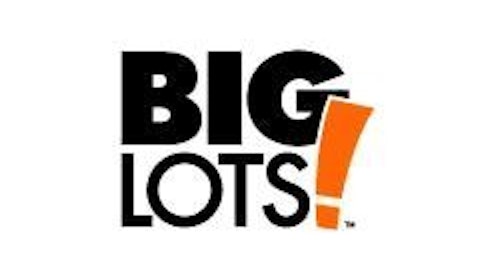As the market has rallied to all-time highs and valuations have expanded, finding bargains has become harder to come by. When pressed for value, should investors turn to the same companies in the stock market as they do in the real world?
Barron’s Magazine recently made a bullish case for Big Lots, Inc. (NYSE:BIG), which attracted my attention.
Shares of the closeout retailer traded as high as $38 preceding its Q1 earnings report on May 30, but shareholders reacted negatively after management cut its Q2 earnings forecast to $0.17–$0.27 from a consensus $0.43. The stock fell 15% on the news.
Why is Barron’s creating a positive spin on Big Lots, Inc. (NYSE:BIG), given the recent sell-off and somber outlook?
First, I don’t always agree with Barron’s, as evidenced by my January piece Why Barron’s is Wrong on PNC Financial. However, it turns out there’s value to uncover at the $1.8 billion retailer. Here are four reasons why readers should consider investing in the closeout retailer:
On April 30, Big Lots, Inc. (NYSE:BIG) announced the hire of David Campisi, age 57, as the company’s new Chief Executive. Campisi has held the chairman and CEO role at Sports Authority and executive merchandising positions at Kohl’s Corporation (NYSE:KSS) and Fred Meyer. The announcement follows the planned retirement of Big Lots, Inc. (NYSE:BIG)’ current CEO, who plagued the company with an insider trading scandal and merchandising missteps.
Earnings per share are expected to climb to $3.30 for the next fiscal year, compared to $2.90 for the current year ending in January 2014. Shares trade at a discounted 11x multiple, compared to 18x earnings for Dollar Tree, Inc. (NASDAQ:DLTR) and 16.5x for Family Dollar Stores, Inc. (NYSE:FDO).
Despite its mixed operating results, Big Lots, Inc. (NYSE:BIG) generates tremendous free cash flow. The company generated $150 million in FCF during fiscal 2012 and $196 million on average during the last five years. Management has spent $1.9 billion since 2005 to repurchase stock, which could boost earnings per share if continued.
The company has virtually no debt — less than $100 million, to be exact. This decreases the risk profile for readers considering a long-term investment. Debt in the retail industry is hard to overcome, as we’ve witnessed in the case of J.C. Penney Company, Inc. (NYSE:JCP).
Discount retail in an improving economy
An improving economy doesn’t necessarily reduce the number of shoppers looking to maximize their hard-earned dollar. Consider the cases of Stein Mart, Inc. (NASDAQ:SMRT) and The TJX Companies, Inc. (NYSE:TJX), both of which are reaching all-time record highs.



